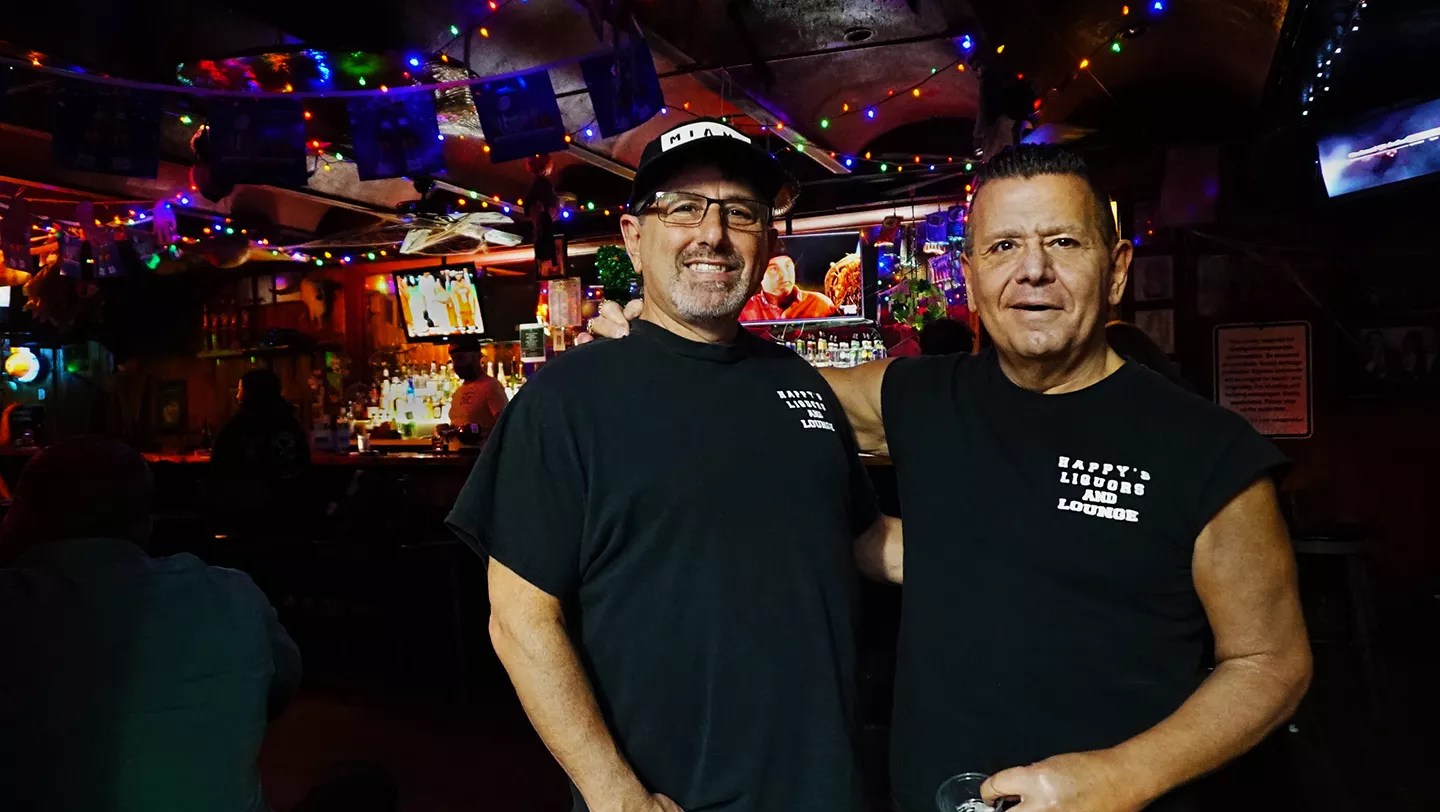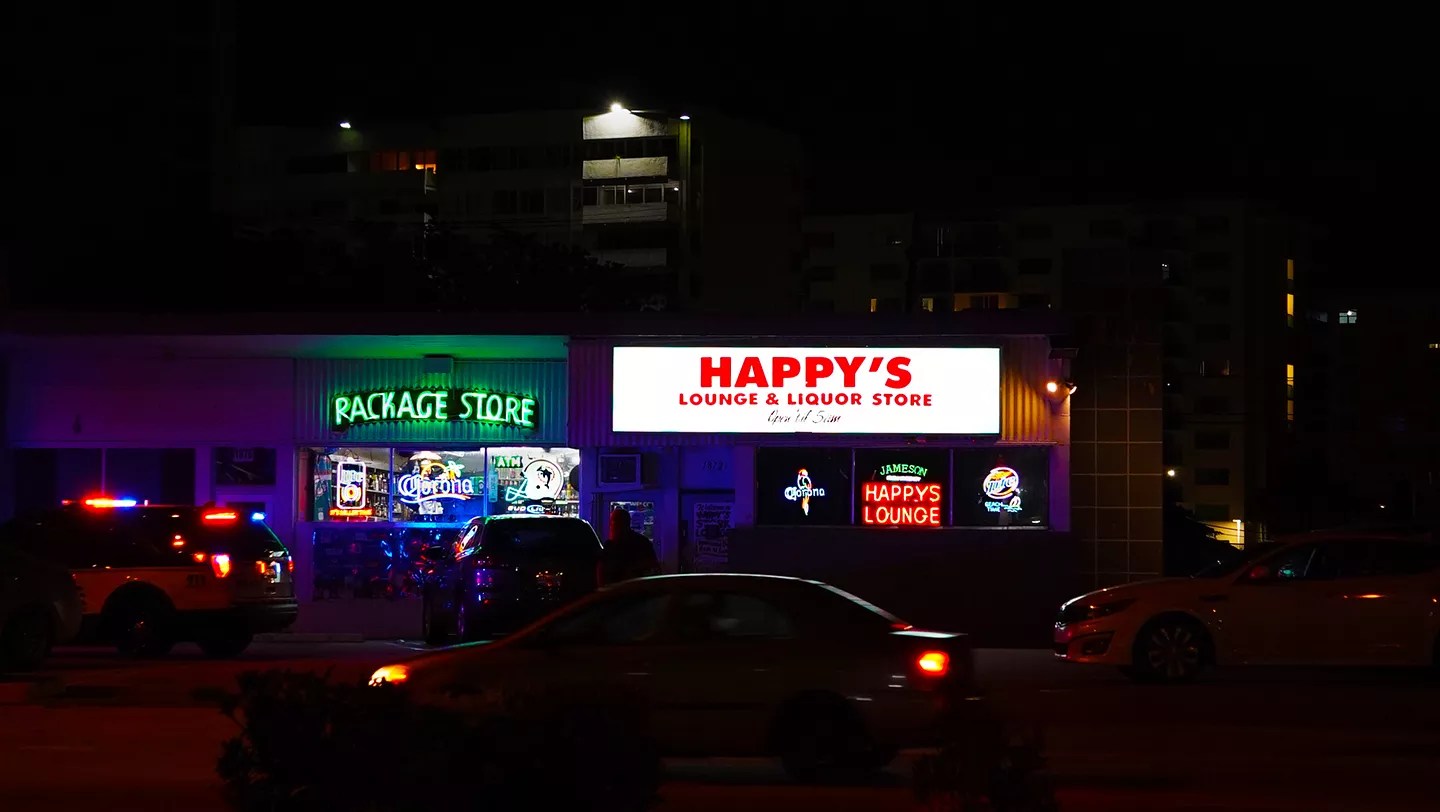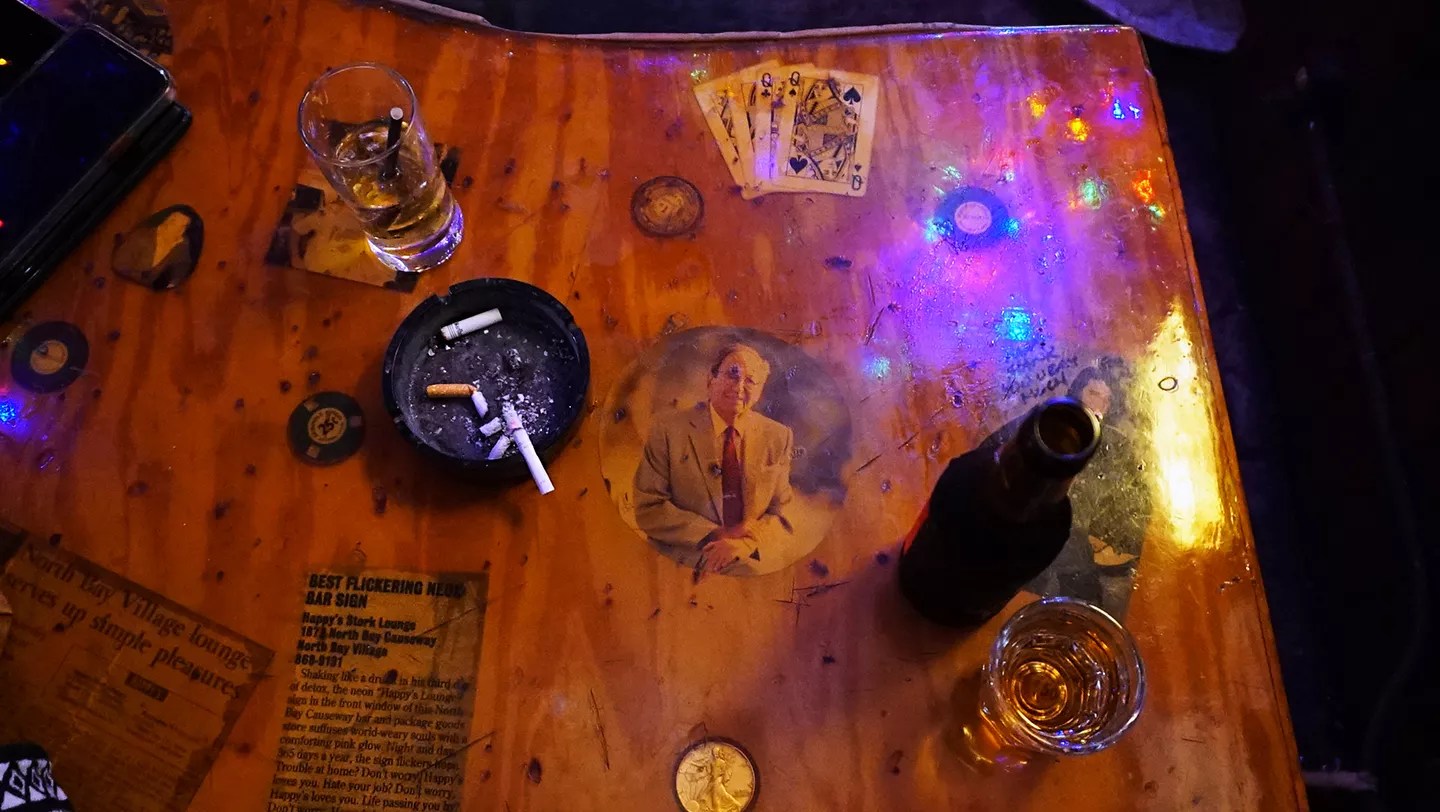
Photo by Jade Finlayson

Audio By Carbonatix
“Miami Tavern Bombed,” blared the headline on the front page of the final edition of the September 22, 1967, Miami News. “A bomb knocked in the rear of Happy’s Stork Lounge on the 79th Street Causeway early today while hoodlum Anthony (Big Tony) Esperti was sitting at the bar with his girlfriend,” began the account, which bore the byline of William Tucker. “It was the tenth recent bombing here in gang terrorism that North Bay Village Police Chief Earl Mitchell said goes back to the ’20s when they would do anything to emphasize a threat.”
The “they” to whom Chief Mitchell referred were the mobsters who frequented the restaurants and bars of North Bay Village in the 1950s and 1960s, when the archipelago of manmade islands inserted between the mainland and Miami Beach’s Normandy Isle was a très chic outpost in Dade County for fine dining and drinking. And it wasn’t only wise guys who were drawn to the glitter and glamour of what is today a sleepy and underdeveloped bedroom community of 8,159 inhabitants situated in the heart of Biscayne Bay. Back then, the east-west causeway that slices through North Bay Village was lined with upmarket steakhouses and watering holes that lured top-drawer celebs like Judy Garland, Jackie Gleason, Frank Sinatra, and his fellow Rat Pack carousers. One of Ol’ Blue Eyes’ wingmen, Dean Martin, the boozy crooner from Steubenville, Ohio, opened a pub called Dino’s in the Village in the mid-’60s and christened it the Show Place of the South.
An empty parking lot now marks the spot where Martin’s tavern once catered to Hollywood’s rich and famous. Right next to it is the last surviving vestige of an era when North Bay Village was the South Beach of the 1950s, and South Beach was better known as God’s waiting room for the blue-rinse set. That relic is Happy’s Stork Lounge and Liquor, a seedy, smoker-friendly dive bar that was licensed in 1952 to an underworld figure named Stefano Randazzo and lives on as a beloved mecca for the economy-class tippling set of North Bay Village, the Normandy Isles neighborhood of Miami Beach, and Miami’s Upper Eastside.
A perennial contender for the title of the region’s best dive bar, Happy’s proudly retains its throwback ambiance and eminently affordable beers and cocktails. (A double-rail vodka and tonic lightens a patron’s wallet by a mere $6.) But nothing is forever in this world, and sometime in April, Happy’s is slated to move out of the strip-mall premises it has occupied for more than 70 years and into a more spacious and far brighter retail space 1,600 feet to the west.
Miami, make your New Year’s Resolution Count!
We’re $16,000 away from our End-of-Year campaign goal, with just a five days left! We’re ready to deliver — but we need the resources to do it right. If Miami New Times matters to you, please contribute today to help us expand our current events coverage when it’s needed most.
Whereas Happy’s has always been a liquids-forward establishment, standard-issue bar snacks and appetizers will be on offer at the new location (which not all that long ago housed an upmarket taco restaurant), and cigarette smokers will be banished to an outdoor patio.
Nevertheless, 61-year-old Steven Inerfeld, who, in partnership with his kid brother Howard acquired Happy’s in 1993, promises that the relocated bar will be “newer, better, and cleaner” than its storied predecessor.
Some longtime elbow benders are dubious of the so-called improvements.
“I’m apprehensive,” says Kelly, a 64-year-old retired bookkeeper from Brooklyn and avid smoker who began frequenting Happy’s in 2002 with her then-husband after they moved into an apartment nearby. “There’s going to be food. And it’s not just the food. It’s going to be very different – it’s just not going to be the same.”
Enter the Shoma Group
For the uninitiated, a true bar – or a “bar bar,” as Jim Atkinson, author of the authoritative 1987 travelogue The View From Nowhere: The Only Bar Guide You’ll Ever Want or Need, dubbed such establishments – views food as a distraction, particularly if it’s not prepackaged in a sealed container or pickled. A bar bar is for the hardcore imbiber who flocks to such an establishment for one overriding reason, and that reason has nothing to do with chicken tenders, Buffalo wings, or mozzarella sticks.
Howard Inerfeld, 58, likes to think of Happy’s as a real-life version of the cozy Boston bar that starred in the 1980s hit TV sitcom Cheers. “We’re on a first-name basis with our customers,” notes Belarusian bartender, Alexi. “We know what they like.”

Passing the bar: Happy’s has been a beacon on the 79th Street Causeway for nearly 70 years.
Photo by Jade Finlayson
When out-of-town visitors to Miami Beach feel like slumming it for a night during their stay, chances are they’ll wind up at Mac’s Club Deuce, the watering hole that began life as a speakeasy during the Prohibition era in the 1920s. But geography aside, what separates Happy’s from its South Beach counterpart is its cohort of regulars, coupled with the comforting knowledge that the bar bar’s staff will take care of its patrons, no matter how legless they may become as the evening spills into the wee hours.
“Mac’s is way more touristy, whereas this is a 100 percent neighborly bar,” opines Patrick Harrington, a thirtysomething database programmer from Maryland who began frequenting Happy’s not long after he moved into a nearby condominium building in January 2009 and now serves as the bar’s operations manager. “We drove two people home last night to make sure they got home safe because they are in the neighborhood. You don’t get that at Mac’s.”
By their own admission, the Inerfeld brothers never would have budged from the bar’s current address had it been up to them. But in May 2021, a Miami residential development behemoth called the Shoma Group bought the corner property where Happy’s now stands for $7.4 million and ponied up another $8.4 million for the capacious adjacent parking lot. The company announced plans to raze the strip mall and, in its place, erect a 19-story condominium tower that will house 333 units and a Publix.
The Shoma Group’s vision is one of several development projects that threaten to transform North Bay Village over the next decade into a blend of Brickell’s gridlocked avenues and teeming sidewalks and the corridor of high-rises that tower over Collins Avenue in Sunny Isles Beach. In that sense, Happy’s date with the wrecking ball can’t be shrugged off as the inevitable fate of an expired relic from a bygone era. The bar’s imminent uprooting is another cautionary tale highlighting the headlong plunge into hyper-development consuming great swaths of Miami Beach and Bay Harbor Islands, not to mention Miami’s mainland bayfront.
“I’m honestly heartbroken because you get a taste of old Miami here where people who don’t make a lot of money can go and relax, and it doesn’t have to be a place that is all glitz and glamour,” says 39-year-old schoolteacher Deniece Williams, gesturing from her barstool perch. “But I see North Bay Village turning into what many other neighborhoods like Brickell and downtown Miami are turning into.”
The municipality’s vice mayor, Richard Chervony, has already seen the village evolve into something quite different from the bland suburb he moved to 30 years ago. The Havana-born physician was drawn to North Bay Island – which, unlike the other two isles that also make up North Bay Village, was zoned exclusively for single-family dwellings. Back then, Chervony says, the neighborhood was mostly Jewish and English-speaking.
The ethnic homogeneity of yesteryear has yielded to a predominantly Latin population composed of U.S.-born Hispanics and Latin American immigrants garnished with a splash of Brazilian nationals to complete the demographic cocktail.
Now 72, Chervony openly acknowledges the pro-development stance he has habitually adopted during his years as an elected member of the village commission. But he doubts whether all the development projects he and his colleagues on the commission have okayed will bear fruit during his lifetime.
“I’d love to see it happen, but I don’t see it happening. None of these properties has a shovel in the ground,” he tells New Times. “What I have seen is a lot of individuals purchasing these empty lots and selling us on the idea of developing them. But they keep flipping them instead.”
Meet Bernard “Happy” Goldlust
The man who gave the bar its name was a natty, pistol-packing curmudgeon from the same town in Ohio that produced Dean Martin. Bernard Goldlust – his real name! – became a North Bay Village fixture in 1955 when he and a partner bought the establishment’s bar and package-store license from one Dominic Civetta, a man described in a 1969 letter written by the commander of the Dade County Public Safety Department’s vice and intelligence section as a “prominent Organized Crime figure.”
“He was a grumpy old man,” recalls Howard Inerfeld, who, along with his sibling Steven, met Goldlust in 1993 when they were negotiating the sale of the business. That he had the nickname “Happy” was wholly ironic in its provenance, Howard asserts. “Like a fat man is called ‘Tiny’ or a bald man is called ‘Curly.'”

“Like a fat man is called ‘Tiny’ or a bald man is called ‘Curly'”: RIP Bernard “Happy” Goldlust, who lent the bar his nickname.
Photo by Jade Finlayson
An accomplished swimmer who eschewed alcohol and always came to the bar dressed in a fashionably cut suit and necktie, Goldlust would sit in the bar’s interior near its front entrance during the late afternoon and watch the tipplers come and go. Dave Fischbein first met Happy as a 15-year-old boy who the proprietor would occasionally ask to deliver liquor to the homes of loyal customers. He got to know Goldlust better when he returned to the premises as an adult in his twenties. But even in his adolescence, Fischbein could detect a certain whiff of the underworld about the Runyonesque bar owner.
“That was the air he would put out, in kind of a secretive way,” says the 66-year-old land surveyor. “He was very observant and street smart, big-time. And if he knew something about the mob, he wouldn’t tell you.”
Much of the vintage patina that differentiates Happy’s from more conventional dive destinations like On the Rocks in North Beach dates to Goldlust’s 37-year tenure as its owner. The cash register nestled among the liquor bottles on the bar’s western side has a distinctively 1950s look. The package-liquor side of the business boasts a black rotary telephone that operates on a landline and is straight out of that same decade. (It proved its worth when a hurricane knocked out local cell networks for days on end.)
Goldlust commissioned a sepia-toned mural that covers much of the eastern wall of the bar and depicts drinkers from different walks of life enjoying beverages and one another’s company. Look closely, and you’ll note that the elegantly coiffed woman clad in a mink stole and clutching a cigarette holder in her right hand is pockmarked with two small-caliber bullet holes, one just to the left of the part in her blond hair, the other slightly to the right of her left nostril.

Look closely at the mural and you’ll note that the face of the elegantly coiffed woman is pockmarked with two small-caliber bullet holes.
Photo by Jade Finlayson
Happy himself didn’t entirely escape the occasionally trigger-happy ways of some of the lounge’s real-life visitors. An undated newspaper clipping tucked under the glass that tops the bar recounts an incident in Happy’s parking lot when Goldlust refused to hand over a wad of cash to a would-be robber and was shot once in the stomach with a .25-caliber pistol in broad daylight. “Bernard (Happy) Goldlust was listed in serious condition and still undergoing surgery late last night,” notes the article.
Goldlust survived his wounds. But by the early 1990s, he’d grown weary of the entrepreneurial life. He told a North Miami-based cousin of the Inerfelds that he was looking to unload the bar that bore his sobriquet, and a deal was done.
The Future of Happy’s Stork Lounge
Howard and Steven have added some technological touches in the intervening years, including an electronic jukebox and, for sports fans, large flat-screen TV monitors that hang from the ceiling. But as moving day looms, the brothers promise to preserve as much of the old Happy’s flavor as they can. About two-thirds of the wooden bar that starts near the neon-festooned front window and winds toward the rear of the current setup will be transplanted to the outdoor patio at the new digs. Some of the sooty posters that adorn the walls will come too, as will the mural, complete with bullet holes. Steven Inerfeld (tending his bar) promises that the relocated Happy’s will be “newer, better, and cleaner” than its storied predecessor. Photo by Jade Finlayson
Beyond that, the middle-term outlook for Happy’s Stork Lounge is about as clear as a frosted beer mug. The Inerfelds’ new landlord will be the Sunbeam Television Company, whose billionaire chief executive officer Andy Ansin completed a $57 million buying spree in the spring of 2021 that saw him snap up six acres of prime (and mostly waterfront) property in North Bay Village. When the lease with Sunbeam comes up for renewal in a scant four years – an eternity in Miami development time – it’s possible that a fleet of bulldozers will be poised to demolish the single-story structure where the brothers and their bartenders will have been pouring $6 double vodka-tonics for 48 months.
But fear not for the long-term prospects of the Inerfeld family business. Until recently, none of the brothers’ three adult children had expressed even the slightest interest in inheriting the taps one day. That changed late last year when Steven’s only child, physical therapist Brittany Inerfeld, pronounced herself an heiress-apparent, eager to learn the finer points of operating a liquor business whose hours are 10 a.m. to 5 a.m., 365 days a year.
“I grew up going to the bar as a kid, and it was torture,” the 30-year-old Long Island native recalls. “But as it got closer to the reality of it closing, I realized how badly I didn’t want to lose the place. I just want to keep the legend alive for my dad because everyone knows him from Happy’s. I don’t see it happening anytime soon, but whenever he feels the need to slow down, I’ll help pick up some of the slack.”
The barflies of North Bay Village and environs will drink to that.